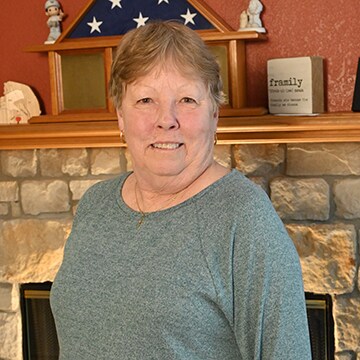Vascular surgery returns patient’s quality of life
For over 22 years, Dawne Morris stood on her feet serving and preparing lunch for the many faces that entered Basehor-Linwood Middle School. So when she began experiencing pain in her legs, she thought it was her age and years of standing on concrete catching up to her.

Dawne Morris
“It felt like someone was squeezing my calves with a vice grip,” said Morris. “The pain would get so intense that I would wake up in the middle of the night with cramps and nothing could relieve the pain.”
Determined to continue enjoying her retirement, Morris refused to let the pain stop her from doing what she loved, including traveling. She made adjustments to how she did daily activities by taking breaks as often as possible.
“The pain only got worse,” said Morris. “When we to Germany last year, I couldn’t walk the hills of the village. That’s when I said to myself, ‘Something isn’t right.’”
Morris was in luck. A few months after her trip to Germany, she went to New York to visit her family. She began talking with her sister-in-law about the location and type of pain she was experiencing. Having experienced similar pain, her sister-in-law told Morris that she may have issues with her veins like she had.
Once she returned home, Morris worked closely with her primary care provider and was given a referral to see a vein specialist.
Morris thought that she would get answers and relief at the vein specialist. However, when the provider saw her, he noticed that it was not an issue with her veins.
“He showed me how when he pressed down on my ankle, instead of returning to its normal color, it stayed white before slowly regaining color,” said Morris. “He let me know that he would refer me to a vascular surgeon to get me relief and solve the issue. It was nice to see how quickly the different doctors could work together to help me find relief.”
Dawne’s recovery begins
Morris was referred to Axel Thors, DO, FACS, a surgeon from The University of Kansas Health System, who works with Lawrence Vascular Surgery. He was able to explain to Morris that her arteries, the system responsible for bringing blood to different parts of the body, were unable to do so due to a buildup of plaque.

Axel Thors, DO, FACS
“She presented to me with peripheral artery disease, or PAD,” said Dr. Thors. “The pain in her calf was the result of it not being able to receive the blood flow. It also was affecting her ability to heal wounds and cuts because the blood was unable to bring nutrition to the area.”
PAD occurs when there is a blockage in the arteries that affects the peripheral artery. The blockage can cause pain in the legs at rest or during activity, swelling and blood clotting. In its advanced stages, wounds cannot heal which can lead to gangrene and amputations. While there is no cure for PAD, lifestyle changes and surgery can eliminate symptoms and improve your quality of life.
“In Dawne’s case, although it was in the advanced stage, we were able to catch it and perform surgery to open the arteries back up,” said Dr. Thors. “Her left leg artery was 80% clogged while her right leg was only 50%.”
According to Dr. Thors, PAD can often go undiagnosed, especially in older individuals with a history of smoking, diabetes and heart disease. In Morris’ case, as a former smoker, she had been complaining about her symptoms for multiple years.
“I was astounded when I received my diagnosis,” said Morris. “I thought since I was being sent to a vascular surgeon that there was something wrong with my heart. Imagine my surprise to learn that Dr. Thors works on all the blood vessels and areas of blood flow.”
With a diagnosis in her pocket, Morris could now begin looking towards a pain-free future. She underwent a minimally invasive surgery where Dr. Thors broke up the plaque blocking her arteries and placed stents into her pelvic arteries to reduce the risk of a blockage developing again.
Get care close to home
Dr. Thors and Lawrence Vascular Surgery are part of LMH Health’s strategic clinical relationship with The University of Kansas Health System, paving the way for clinical partnerships that increase patient access to specialty care in and around Douglas County.
Click here to learn more.
“The surgery went well,” said Morris. “I was able to walk out of the hospital on the same day of my operation, and the only limitation I had was that I couldn’t lift anything heavy and to take it easy. I felt immediate relief and five days later I went shopping in Legends for about six hours.”
With her PAD now under control, Morris is able to get back to planning an active future, which includes returning to Germany and walking through the villages.
“If you are ever having continuous leg pain or cramping, go get it looked at,” said Morris. “Don’t push it off as just a symptom of getting older like I did.”
Since Morris will always be at risk of developing a new blockage in her arties, she must undergo routine testing every six months.
“The ankle-brachial index, ABI, tests measures your blood flow in your arm, ankle and feet,” said Dr. Thors. “Here at LMH Health, we have a machine called the Park’s machine which is able to perform the screen, and any provider can order the test.”
Individuals who are 40 and older with a history of smoking, diabetes, high cholesterol or heart disease are recommended to screen for PAD using the ABI test. Your primary care provider is able to order the ABI screening throughout the year. It should be used in addition to your annual physical and health screenings.
“Although it’s a disease that won’t go away and I’ll have it for the rest of my life, I am confident that I will still have a great life,” said Morris. “I feel better and healthier.”